Welcome to the first module of your Level 3 Certificate in Electrical Pre-Trade. This course covers the skills needed to kick-start a career in the electricity industry. Electricity is a serious workplace hazard and accidents can often be fatal, so the focus of this introductory course is safety: your safety; the safety of others; safe practices; and a safe environment.
We begin with a basic overview of the legal requirements for working safely in the electrical industry, in particular the Health and Safety at Work Act (HSWA), Electricity (Safety) Regulations and AS/NZS 4836. Once you have an appreciation of the legislation, we will learn more about the dangers of electricity and how accidents might be prevented. The final section of the online course is about identifying hazards and risk management.
During the face-to-face sessions of Module One you will practice safe testing for voltage, safe use of hand power tools and learn about first aid in electrical workplace. You will also have the opportunity to carry out a risk management assessment. As part of this course, you will complete CPR training through an external provider.
This online self-paced resource contains daily ‘lessons’ as well as self-directed learning (SDL). The SDL reinforces and clarifies what you cover in the lessons, plus it helps you to prepare for the assessments. Make sure you commit to putting in the extra hours required – the final result will be worth it.
Overview of Safety and Risk Control in Electrical Workplace
- Credits: 12
- Length: 14 days (including 2 days externally assessed First Aid training)
Learning Outcomes:
- LO 1.1. Demonstrate knowledge of the Health and Safety at Work Act and general safety practices in the electrical workplace.
- LO 1.2. Demonstrate introductory knowledge of electricity and other hazards, their effects on people and animals and procedures for their safe management and control.
- LO 1.3. Demonstrate introductory knowledge and use of electrical test instruments for measurements and circuit isolation.
- LO 1.4. Demonstrate fundamental knowledge and practice application of first aid and CPR for the electrical trade.
Unleash your inner ELECTRICIAN!
In order for you to gain the most value from your qualification and to prepare you for your assessment and the industry, make sure you complete all of the SDL tasks.
| Day One | Day Two | Day Three | Day Four | |
|---|---|---|---|---|
| Course Content |
Introduction HSWA 2015 |
Electrical (Safety) Regulations 2010 |
AS/NZS 4836:2011 Circuits, voltage and current |
Review Day 1 Start glossary |
| Self-directed Learning |
Exercise 1 Exercise 2 |
Exercises 3-5 |
Exercises 6-7 Electricity explained Exercises 8-9 Self-directed Learning |
HSWA revision questions Electrical fatalities Numeracy and Excel activity Reading scales |
In order for you to gain the most value from your qualification and to prepare you for your assessment and the industry, make sure you complete all of the online and SDL tasks.

What we're covering:
- electrical industry career paths
- sharing your 'why'
- electrical terms glossary
Let’s get started!
There is a range of electrical trades available in New Zealand and the outlook for this career option is good due to the construction boom and a shortage of skilled electrical workers.
One of the most attractive reasons for joining the electrical trade is the number of career paths that the industry offers.
- Electrical designer
- electrical technician
- cable joiner
- electrical installation specialist
- electrical appliances services
- line workers
- electrician
- renewable energy technician
- electrical inspector
- electrical engineer
Click on the links below or scan the QR codes with your phone to learn more about becoming an electrician and an electrical engineer.
Electrician/Kaimahi Hiko

Electrical Engineer/Mataaro Puuhiko

Exercise 1
Why you’re here – sharing your why.
Share your answers to these questions in the discussion forum:
- What attracted you to an Electrical Trade career?
- What skills and knowledge do you think you will need for this career?
- What job do you see yourself doing in 5 years’ time?
Self-directed Learning
As you work through this qualification you will come across a lot of new words. Electricity has its own language! Now is the time to set up a glossary. Download the glossary HERE. Write the meaning of each term as you come across it in your own words. You will be able to type directly into it once you save it to your device.
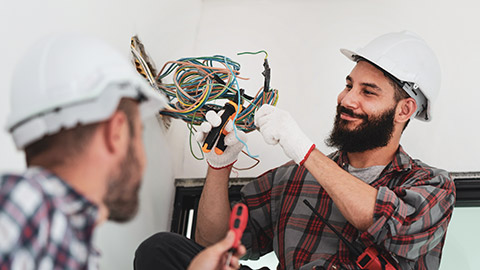
What we're covering:
- Health and Safety at Work Act (HSWA)
- Be a Safe Guy and Puataunofo
The Health and Safety at Work Act (HSWA) came into effect in 2016. It is the key work health and safety law in New Zealand and covers nearly all work and workplaces.
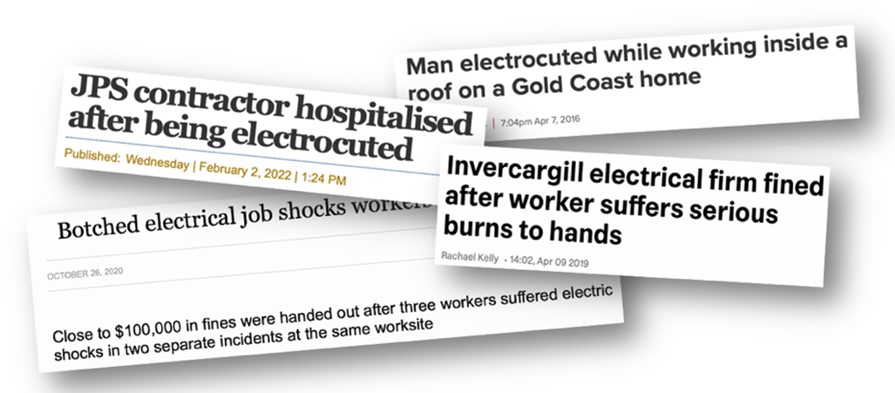
Its aim is to protect workers and other people against harm to their health, safety and wellbeing by eliminating or minimising risks at work. People are the most important asset in any business or organisation, and ensuring their health and safety is critical.
He aha te mea nui o te ao? He tāngata. He tāngata. He tāngata. What is the greatest treasure in the world? It is people. It is people. It is people.
The complete Health and Safety at Work Act can be found here, or you can view it on your mobile phone by scanning the QR code:

However, you may find the HSWA guides here and here easier to understand for later reference:


Watch the video explaining the HSWA. Fill in the missing terms as you proceed. This is an excellent summary of the Act for you to refer back to.
Click on the links below introducing the ‘Be A Safe Guy’ and the Puataunofo campaigns.
Puataunofo 'Come Home Safely' programme

However you say it, be a safe guy - WorkSafe New Zealand

Self-directed Learning
The paragraph below provides a brief description of the Health and Safety at Work Act (2015). Read it carefully, then fill in the blanks using the corresponding letters from the table below.
According to the Health and Safety at Work Act (2015), employers or officers in a workplace must take some key steps. Which three steps does this include?
Read the statement and question below, then select the three descriptions that most accurately answer the question.
What we're covering:
- The Electrical (Safety) Regulations 2010
- AS/NZS 4836/2011
- Electrical fatalities in NZ and Australia
You should now have a greater understanding of the HSWA and its role in protecting you and your workmates against harm to your health, safety and wellbeing by eliminating or minimising risks at work.
Other safety legislation particular to the electricity industry includes:
The Electrical (Safety) Regulations 2010 promote the health and safety of members of the public, and promote the prevention of damage to property, around the supply and use of electricity in New Zealand. They gather together and state the generic rules and requirements about electrical safety, and what is deemed to be electrically safe and electrically unsafe. The Regulations are intended to help businesses understand how to manage particular electrical hazards.
Read more about the Regulations on the WorkSafe site here or scan the QR code with your phone:

The complete Electricity (Safety) Regulations 2010 document can be found here:

Exercise 3
Refer to the Electrical Safety Regulations to answer the following questions.
Exercise 4
Which item in the Regulations would you refer to if you wanted more information about:
Exercise 5
The table below contains summaries of some sections from the Electricity (Safety) Regulations 2010.
AS/NZS 4836:2011 is further legislation dealing with safety – in particular “safe working on or near low-voltage electrical installations and equipment”.
The Standard covers a wide range of safety issues that electrical workers face every day, providing a minimum set of procedures, safety requirements and recommendations to manage the hazards associated with electricity, specifically arc blast, arc flash, electric shock and electrocution.
Exercise 6
Section 3.1.1 of the standard AS/NZS 4836:2011 describes the hierarchy of controls to implement when treating risk.
Exercise 7
Section 5.1.1 of the standard AS/NZS 4836:2011 describes the safe use of ladders and stepladders.
Self-directed Learning
Study the chart which shows electrical fatalities from Australia and New Zealand between 2000 and 2017.
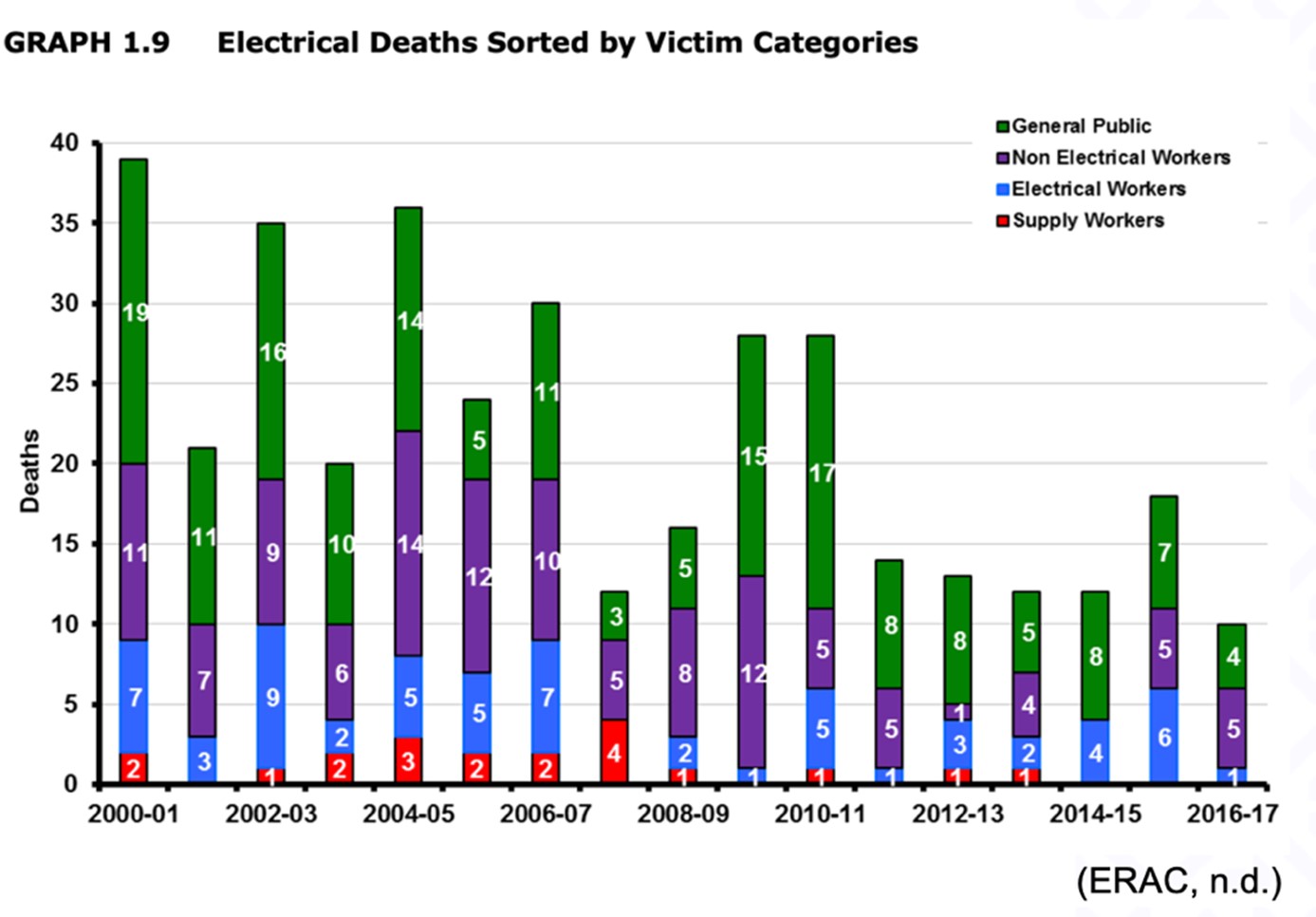
Download the SDL M1D1 Worksheet to your device and complete the questions.

What we're covering:
- atoms and electrons
- insulators and conductors
- circuits
- voltage and current
- resistance
Electricity is all around us - powering technology like our cell phones, computers, lights, and even cars. It is also be found throughout nature, from lightning in a thunderstorm to synapses inside our body.
All matter is made up of atoms, but even the atom isn't small enough to explain the concept of electricity. We need to look at the building blocks of atoms: protons, neutrons, and electrons.
Read the information at this link or scan the QR code with your phone.

Exercise 8
Electricity is defined as the flow of electric charge. If we can free an electron from the outer orbit of an atom and force it to move, a current of electricity is created. This is what happens in a piece of wire. The electrons are passed from atom to atom, creating an electrical current from one end to other.
Watch this animation of electron movement or scan the QR code with your phone.

Some things hold their electrons very tightly and electrons do not move through them very well. These things are called insulators. Rubber, plastic, cloth, glass and dry air are good insulators and have very high resistance.

Materials with loosely held electrons, which move through them very easily are called conductors. Most metals - like copper, aluminum or steel - are good conductors.
Circuits
Electricity is the flow of electric charge. A circuit is a path for electricity to move through - a closed loop of conductive material that allows charge carriers to flow through continuously without beginning or end.
Properties of electricity:
- must complete a circuit
- seeks easiest and "all" paths to ground
All circuits have some basic parts, called components.
- One component is the power source, also called a voltage source (like a battery). The power source is what pushes the electricity through the circuit.
- Next, circuits need connectors to connect all the parts of the circuit and create the path or loop for the electricity to travel through. Connectors are often made of wire or other metal.
- A third component is the load. This is the thing being powered by the electricity in a circuit, such as a light bulb, heater, power tool etc.
- Finally, most circuits will have a switch that turns the power on and off.
The load converts electrical energy to some other form of energy. A circuit with no load is called a short circuit. In a short circuit, the power source feeds all of its power through the wires and back to itself, and either the wires melt, or the battery blows up, or worse!
System voltage and load resistance determine the flow of current. During a short circuit, only the resistance of the fault path limits current. Current may increase to many times the load current.
When you plug in a device (e.g., a power tool), the electricity takes the easiest path from the plug-in to the tool, and back to the power source. This action is also known as creating or completing an electrical circuit. If a circuit is “broken,” (the tool is switched off), its conductive elements no longer form a complete path, and continuous charge flow cannot occur in it.
Voltage and current
The electrical energy in a circuit can be measured in terms of both current and voltage.
Voltage is what makes electric charges move. It is the 'push' that causes charges to move in a conductor. It is the "energy per unit charge”. Specifically, voltage is measured as the difference in electrical energy between two points in a circuit. Voltage is measured in units of volts using a voltmeter; the symbol for volts is V. Voltage may come from a battery or a power plant.
Current is the rate at which electric charge flows past a point in a circuit per second.
Current is measured in units of amperes, or amps, using an ammeter; the symbol for amperes is A.
Think of water running through a pipe: current is a measure of how much water is flowing through the pipe per second; voltage is a measure of how forcefully the water is pushing past a given point.
These links will take you to videos explaining electric basics if you’re a bit rusty.
Electrical Basics for Beginners: Volts, Amps and Ohms
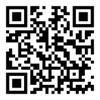
Charge and Current - What is Electricity?
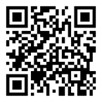
Exercise 9
Find out what Resistance is and write a definition in your own words. What are the units for resistance? (Add information to your glossary.)
Self-directed Learning
Reading scales
During Course 1 you will be using meters to measure current, voltage and resistance. It is important you can accurately read scales since not all equipment is digital.
To determine the value of each little mark between numbered values in a scale reading, find the difference between successively numbered values then divide by the number of spaces.
Example:
| Difference between 20 and 30 is 30 - 20 = 10 Number of spaces between 20 and 30 is 10 ∴ each interval = 10 ÷ 10 = 1 |
|
| Difference between 5 and 6 is 6 - 5 = 1 Number of spaces between 5 and 6 is 10 ∴ each interval = 1 ÷ 10 = 0.1 |
|
| Difference between 100 and 200 is 200 - 100 = 100 Number of spaces between 100 and 200 is 5 ∴ each interval = 100 ÷ 5 = 20 |
Download the M1D4 Worksheet to your device and complete the activities.


